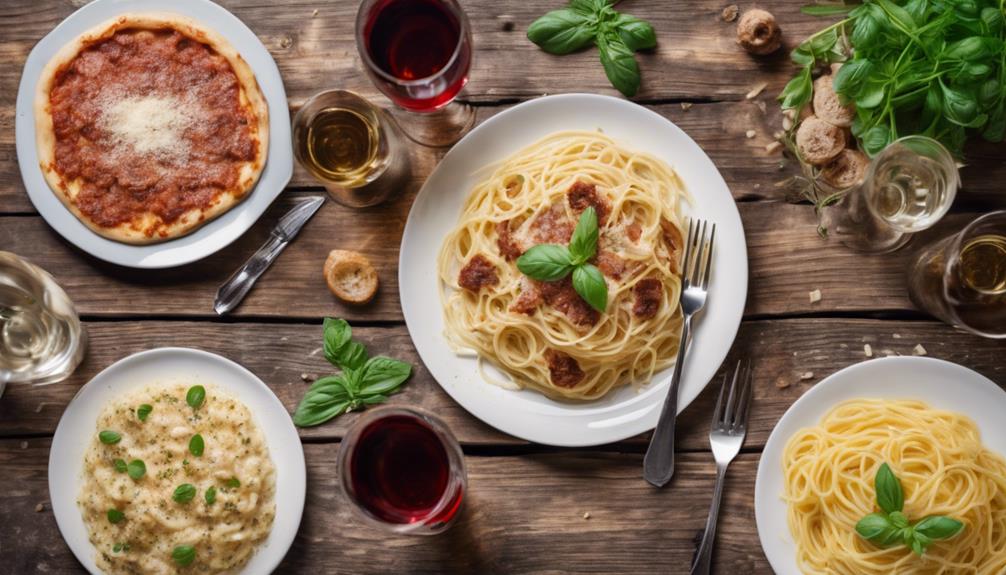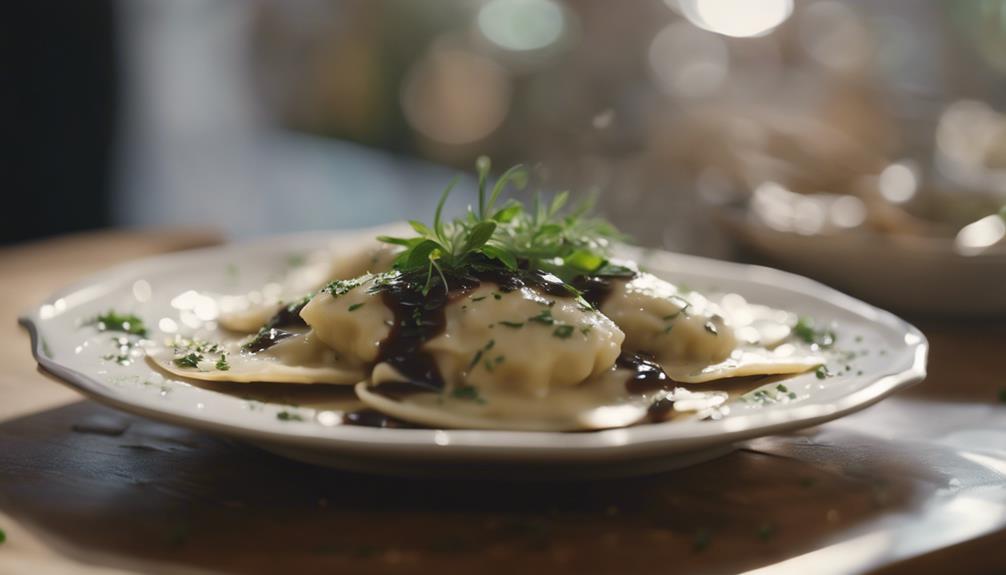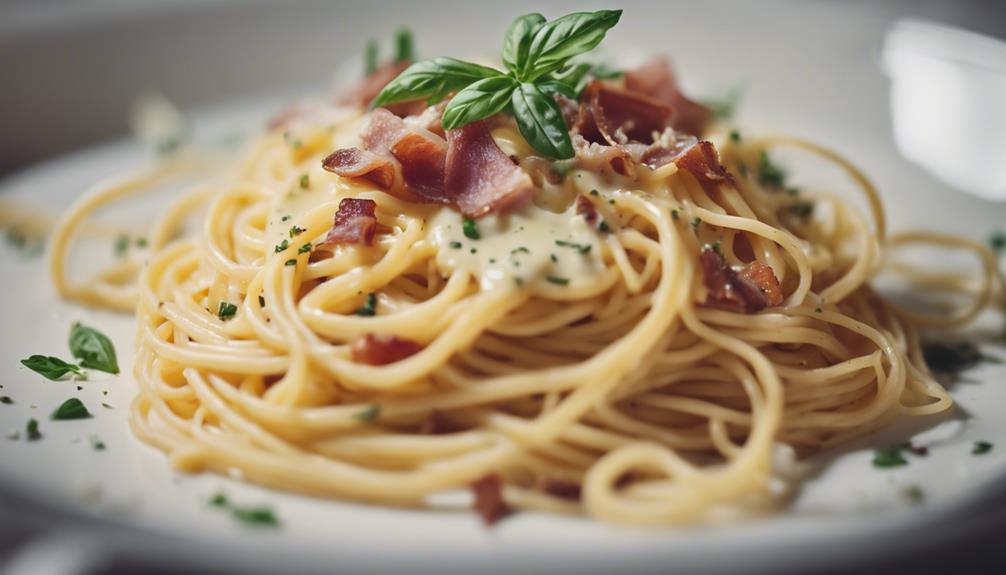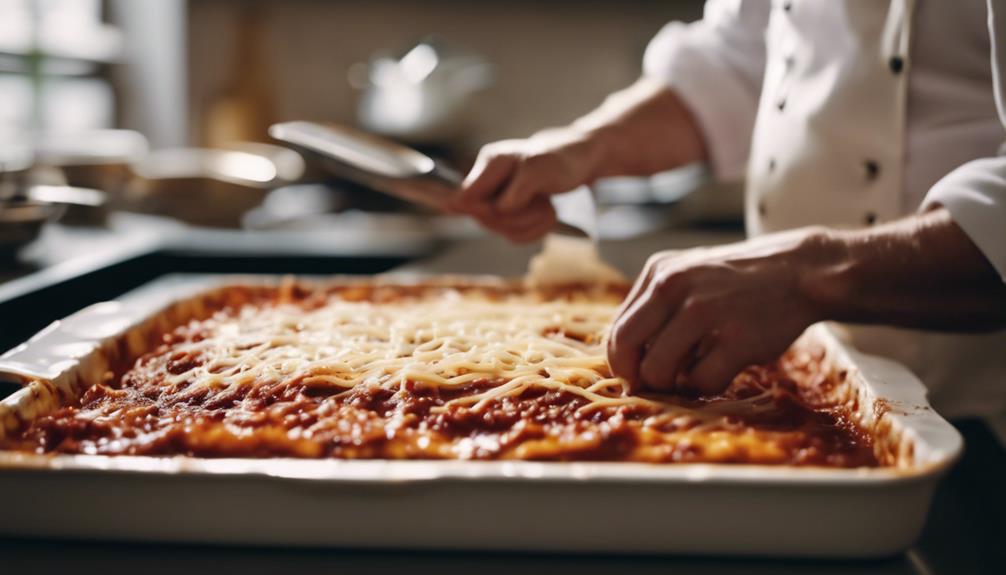If you are craving a taste of Italy, dive into famous Italian dishes such as lasagna, Margherita pizza, Tiramisu, and Osso Buco. Delve into a wide array of pasta options ranging from the North to the South of Italy. Naples, the birthplace of pizza, offers traditional favorites like Marinara and Quattro Stagioni. Be sure to try the smooth Pannacotta and the flavorful Cacio e Pepe pasta. From seafood dishes like Cioppino to the rich Bistecca alla Fiorentina, the peninsula has something for every taste. Continue on this delectable journey through Italy’s culinary wonders for an unforgettable experience.
Key Takeaways
- Italian pasta dishes like Lasagne alla Bolognese and Gnocchi di Patate are renowned worldwide.
- Naples is famous for creating classic pizzas such as Margherita and Marinara.
- Tiramisù, Pannacotta, and Cannoli are popular Italian desserts loved for their rich flavors.
- Northern Italy offers meat dishes like Osso Buco and Brasato di Fassona Piemontese.
- Italian cuisine highlights seafood specialties like Cioppino and Swordfish Sicilian-Style.
Traditional Italian Pasta Dishes
What're some classic pasta dishes that are considered traditional in Italian cuisine?
Italian pasta dishes are a cornerstone of the country's culinary heritage, offering a diverse array of flavors and textures.
From the rich and hearty Lasagne alla Bolognese to the simple yet delicious Fettuccine al Pomodoro, pasta dishes in Italy showcase a deep-rooted love for pasta, sauce, and cheese.
The marriage of perfectly cooked pasta with luscious sauces like Bolognese, Carbonara, and Pesto creates a symphony of taste that has captivated food enthusiasts worldwide.
Italian cuisine also boasts Gnocchi di Patate, delicate potato dumplings that melt in your mouth, and Ravioli, pasta pockets filled with savory ingredients like cheese or meat.
Each region in Italy puts its unique spin on pasta, showcasing a kaleidoscope of cooking styles and ingredients.
Whether you prefer a classic Spaghetti Aglio e Olio or a decadent Tortellini in Brodo, Italian pasta dishes never fail to satisfy cravings and bring joy to the table.
Iconic Pizza Varieties

Originating in Naples, boasting a crispy crust and a medley of toppings, iconic pizza varieties are celebrated worldwide. The city of Naples in Southern Italy is renowned for creating the original pizza, a dish that has become a symbol of Italian food. Classic Italian pizzas such as Margherita, Marinara, and Quattro Stagioni showcase the simplicity and deliciousness of this beloved dish. People from Northern Italy to far-flung corners of the globe enjoy the diverse flavors and styles of pizza, each pizzeria offering its own unique twist on the classic recipe.
Let's take a closer look at some iconic pizza varieties:
| Pizza Variety | Toppings |
|---|---|
| Margherita | Tomato sauce, mozzarella, basil |
| Marinara | Tomato sauce, garlic, oregano |
| Quattro Stagioni | Mushrooms, ham, artichokes, olives |
| Capricciosa | Ham, artichokes, mushrooms, olives, eggs |
With their perfect balance of flavors and textures, these pizzas continue to captivate taste buds worldwide.
Delectable Italian Desserts

Explore the sweet side of Italian cuisine with a delightful array of delectable desserts that are sure to satisfy your cravings. Indulge in these mouthwatering Italian desserts:
- Tiramisù: Layers of coffee-soaked biscuits and creamy mascarpone cheese, topped with cocoa powder, create a heavenly dessert that balances sweetness and richness perfectly.
- Pannacotta: This famous Italian dessert is beloved for its light and silky texture, often flavored with golden sugar and set with gelatin, offering a delicate treat that melts in your mouth.
- Cannoli: Traditional Sicilian pastries filled with sweet ricotta cheese and candied fruit, encased in a tube-shaped shell, and dusted with powdered sugar, Cannoli are a delightful combination of crispy and creamy flavors.
Whether you prefer the creamy goodness of Pannacotta, the rich layers of Tiramisù, or the crunchy sweetness of Cannoli, Italian desserts offer a diverse range of flavors and textures to satisfy any sweet tooth.
Popular Regional Meat Dishes

If you're a meat lover, get ready to tantalize your taste buds with the diverse meat dishes from different regions of Italy.
From Northern meat specialties to Southern meat delicacies, Italy offers a wide array of flavors and cooking styles that showcase the country's culinary diversity.
Whether you prefer the hearty braised beef from Piedmont or the flavorful breaded pork chops from Milan, there's a regional meat dish waiting to satisfy your carnivorous cravings.
Northern Meat Specialties
In Northern Italy, meat enthusiasts can indulge in a variety of tantalizing regional specialties that showcase the rich culinary heritage of the area. Here are some popular Northern meat dishes you must try:
- Osso Buco from Milan: A flavorful dish made with cross-cut veal shanks, vegetables, white wine, and broth, creating a succulent and tender meat experience.
- Brasato di Fassona Piemontese: A Piedmontese braised beef dish slow-cooked to perfection, offering a melt-in-your-mouth texture and rich, savory flavors.
- Chicken Scarpariello: This dish features chicken cooked with sausage, peppers, and rosemary, resulting in a delightful blend of flavors that will leave you craving more.
Northern Italy is also known for its classic meat dishes like Braciole, Pork Chop Milanese, and Stracotto di Fassona Piemontese. These dishes showcase the diverse culinary traditions of the region, providing a range of options for meat lovers seeking a taste of authentic Northern Italian cuisine.
Southern Meat Delicacies
Southern Italy boasts a delectable array of popular regional meat dishes that highlight the diverse and flavorful culinary traditions of the area. From the renowned Bistecca alla Fiorentina hailing from Tuscany to the Sicilian Stracotto di Fassona Piemontese, each dish showcases a unique blend of Italian ingredients and regional influences.
Puglia's Pork Chop Milanese offers a Southern Italian twist on the classic veal cutlet, breaded and fried to perfection. Calabria's Chicken Scarpariello brings a spicy kick with vinegar, garlic, and hot cherry peppers, creating a tantalizing flavor profile. Additionally, Campania's Florentine Butter Chicken presents a delightful variation of the traditional Florentine steak, featuring succulent chicken cooked in butter and aromatic herbs.
These Southern meat delicacies not only satisfy the palate but also provide a glimpse into the rich culinary heritage of Italy's diverse regions, inviting you to savor the flavors of the Mediterranean with every bite.
Classic Italian Seafood Specialties
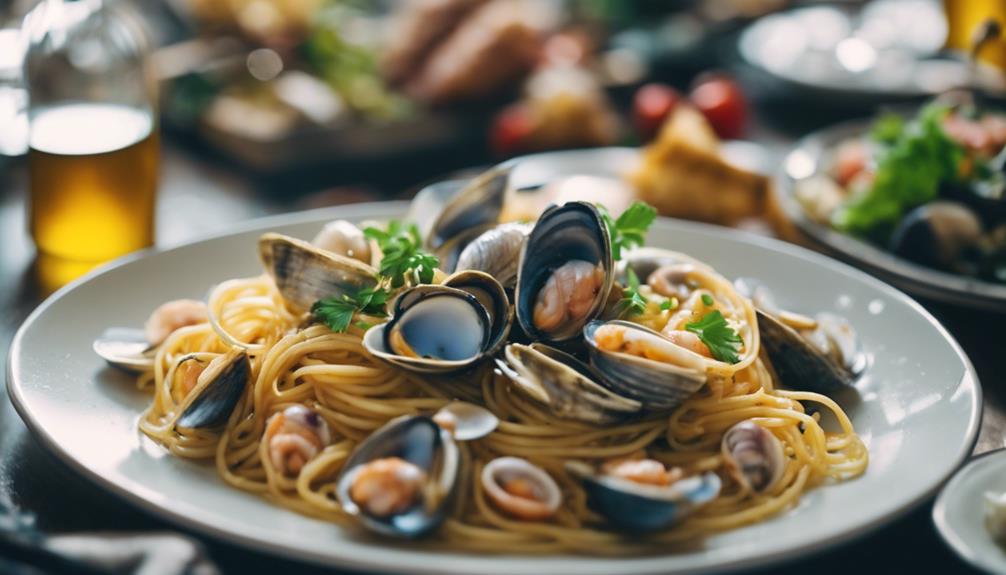
Explore the delectable world of Classic Italian Seafood Specialties, showcasing a rich variety of traditional dishes that highlight the bounty of the sea. In Italian cuisine, seafood takes center stage in many beloved recipes, especially during festive occasions like Christmas Eve. Let's delve into some classic Italian seafood specialties:
- Cioppino: This seafood stew is a flavorful medley of fresh seafood simmered in a savory tomato-based broth, creating a rich and comforting dish perfect for seafood lovers.
- Swordfish Sicilian-Style: Indulge in the succulent flavors of swordfish prepared Sicilian-style, with the delightful combination of capers, olives, and tomatoes infusing the dish with Mediterranean flair.
- Cavatelli with Mussels, Lillet, and Dill: Savor the taste of homemade cavatelli pasta paired with plump mussels and aromatic dill, creating a harmonious blend of flavors that's both elegant and satisfying.
Italian-American traditions also celebrate seafood feasts, showcasing the diverse and delicious offerings of the sea in a true culinary delight.
Timeless Italian Appetizers

Discover a selection of timeless Italian appetizers that showcase the essence of traditional flavors and culinary craftsmanship. These appetizers serve as the perfect prelude to a delightful main meal, offering a glimpse into the rich tapestry of Italian cuisine. From the classic bruschetta to the indulgent arancini, each bite promises a burst of authentic flavors that will leave you craving for more.
Check out the table below for a quick overview of these beloved Italian appetizers:
| Italian Appetizers | Description | Key Ingredients |
|---|---|---|
| Bruschetta | Toasted bread topped with tomatoes, basil, garlic, and olive oil | Bread, tomatoes, basil, garlic, olive oil |
| Antipasto Platters | Assortment of cured meats, cheeses, olives, and marinated vegetables | Cured meats, cheeses, olives, marinated vegetables |
| Arancini | Deep-fried rice balls filled with ragu, cheese, and peas | Rice, ragu, cheese, peas |
These appetizers not only tantalize the taste buds but also embody the heart and soul of Italian culinary traditions. Next time you sit down for a meal, consider starting with one of these delightful creations to elevate your dining experience.
Must-Try Italian Comfort Foods
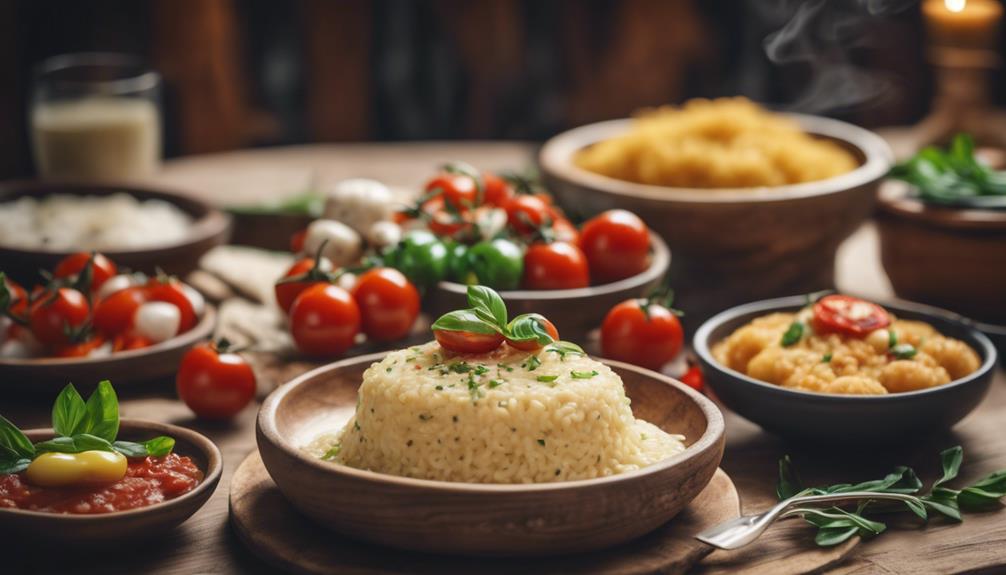
If you're craving comfort, don't hesitate to indulge in classic Italian pasta, rich, creamy risotto, and decadent tiramisu dessert.
These dishes aren't just food; they're a warm hug for your taste buds, bringing a sense of coziness and satisfaction with every bite.
Classic Italian Pasta
Indulge in the comforting flavors and textures of classic Italian pasta dishes like spaghetti, fettuccine, and penne. These beloved pasta dishes aren't just a meal; they're a gastronomic experience that embodies the heart and soul of Italian cuisine.
Here are some fascinating facts about traditional Italian pasta:
- Homemade Pasta: Making pasta from scratch is a time-honored tradition in Italy, where families pass down recipes through generations, resulting in unique textures and flavors.
- Regional Variations: From the hearty ragu of Bologna to the creamy carbonara of Rome, Italian pasta dishes showcase the diverse regional flavors and ingredients found across Italy.
- Primo Course: In Italian dining, pasta is typically served as a primo, the first course that sets the stage for the rest of the meal, emphasizing the importance of pasta in Italian culinary culture.
Next time you sit down to enjoy a plate of classic Italian pasta, savor each bite knowing that you're experiencing a culinary tradition that has stood the test of time.
Rich, Creamy Risotto
Reveal the irresistible allure of rich, creamy risotto, a must-try Italian comfort food that tantalizes the taste buds with its velvety texture and diverse flavors.
This Italian rice dish, often associated with Northern Italy, is made using Arborio rice, known for its ability to absorb liquids and release starch, resulting in a creamy sauce.
One of the most famous variations is Risotto alla Milanese, infused with saffron, giving it a vibrant yellow hue and a subtle earthy taste.
The magic of risotto lies in the slow cooking process, where the rice is gradually cooked in broth while being continuously stirred, creating that signature creamy consistency.
Whether you choose a classic Risotto alla Milanese or explore other versions like Risotto ai Funghi with mushrooms, each bite offers a comforting experience that embodies the heartiness of Italian cuisine.
Decadent Tiramisu Dessert
Explore the luscious world of decadent Tiramisu dessert, a delightful Italian treat that promises to captivate your taste buds with its layers of coffee-soaked ladyfingers and creamy mascarpone cheese.
This pick-me-up dessert, originating from the Veneto region of Italy, is a perfect blend of flavors and textures. Here are a few reasons why Tiramisu should be on your must-try list:
- Classic Italian Dessert: Tiramisu is a quintessential Italian dessert loved for its unique combination of ingredients.
- Indulgent Layers: Enjoy the contrast between the soft, coffee-infused ladyfingers and the rich, velvety mascarpone cheese.
- Cocoa Powder Finish: The dusting of cocoa powder on top adds a decadent touch, enhancing the overall flavor profile.
The name 'Tiramisu' translates to 'pick me up' in Italian, fitting for a dessert that not only uplifts your spirits but also satisfies your sweet cravings.
Don't miss out on this heavenly delight that blends coffee, cheese, and sweetness into one harmonious creation.
Frequently Asked Questions
What Are the Top 10 Italian Dishes?
You should explore the top 10 Italian dishes for a delightful culinary experience. From lasagne alla Bolognese to pollo alla Cacciatora, each dish offers a unique blend of flavors that will tantalize your taste buds.
What Are 5 Traditional Italian Dishes?
When thinking of traditional Italian dishes, imagine a table laden with flavors. From lasagna and fettuccine to gnocchi and melanzane, you savor each bite. Pollo alla Cacciatora completes the feast, a symphony of Tuscan flavors.
What Is Italy's Most Popular Dishes?
When it comes to Italy's most popular dishes, you can't go wrong with classics like lasagne alla Bolognese, fettuccine al Pomodoro, gnocchi di patate, melanzane alla Parmigiana, and pollo alla Cacciatora. These traditional flavors delight taste buds worldwide.
What Are 3 Famous Foods From Italy?
When looking for 3 famous foods from Italy, you can't go wrong with lasagne alla Bolognese for rich flavors, fettuccine al Pomodoro for a classic taste, and gnocchi di Patate for a delightful twist on pasta. Enjoy the culinary journey!
What Are Some Authentic Italian Dishes Served at Luna Italian Cuisine?
Indulge in the exquisite flavors of Italy at Luna italian cuisine: hidden gem. Savor the rich and savory taste of homemade pasta dishes like spaghetti carbonara and fettuccine Alfredo. Don’t miss out on the tantalizing flavors of authentic Italian pizzas and creamy tiramisu for dessert. Luna Italian Cuisine: Hidden Gem is a must-try for all food enthusiasts.
Conclusion
To sum up, the world of famous Italian dishes is a culinary paradise waiting to be explored. From traditional pasta dishes to iconic pizza varieties and delectable desserts, Italy offers a feast for the senses that will leave you craving more.
So, next time you're in the mood for a taste of Italy, indulge in these timeless classics and experience a gastronomic journey like no other. Buon appetito!
